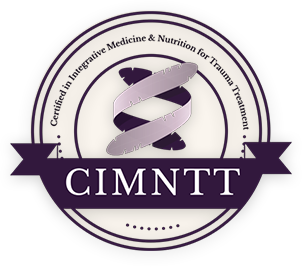Certificación
The Role of Nutrition in Telomere Maintenance and Biological Aging
Telomeres, the protective caps at the ends of chromosomes, are a window into how the body is aging at a cellular level. Recent research suggests that diet may influence how quickly these telomeres shorten. This connection points to an important idea: the food we eat may play a role not just in how we feel day to day, but in how our cells age over time.

As we support our clients through aging, we often see needs that conventional medicine tends to overlook—especially the need for intentional, therapeutic nourishment. Nutrition is one of the most powerful ways we can influence how the body responds to stress, heals, and maintains resilience over time. These deeper layers of care become even more important as the body changes and cellular aging accelerates.
Telomeres, the protective caps at the ends of our chromosomes, offer a window into this process. Their length reflects not only our genetic blueprint but also the cumulative effects of stress, inflammation, nutrition, and lifestyle. Because bioindividuality has always been central to my practice, I’m continually drawn to how appropriate nutrition, which keeps our body's engine running smoothly, can influence aging at the cellular level.
Recent studies offer important insights into how specific foods, dietary patterns, and inflammatory pathways may protect or erode telomere length across the lifespan.
Below, I review five papers that explore this connection from different angles—ranging from nutrigenomics and inflammation to Mediterranean dietary patterns and childhood nutrition.
The first study, a review, examined the emerging evidence linking dietary habits to telomere maintenance. The authors explain that telomeres play a central role in cellular aging and that disruptions in telomere biology are tied to premature aging and age-related diseases. They highlight research suggesting that certain dietary components—likely through antioxidant and anti-inflammatory pathways—may help preserve telomere integrity. Although the evidence is promising, the review emphasizes that rigorous, long-term studies are still needed to clearly connect specific dietary interventions with telomere preservation in humans.
The second study, a systematic review of nine papers involving more than 120,000 participants, explored whether pro-inflammatory diets are associated with shorter telomeres. Four of the included studies found a clear link: higher scores on the Dietary Inflammatory Index—reflecting more inflammatory eating patterns—were associated with shorter telomere length. Still, because the findings across all studies were inconsistent and many lacked complete dietary data or long-term follow-up, the authors note that stronger research is needed before drawing firm conclusions.
The third study offered a narrative review of the Mediterranean diet and its relationship to telomere biology. The authors discuss how individual components of the diet—polyphenols, healthy fats, vitamins, minerals—may support telomere maintenance by reducing oxidative stress, lowering inflammation, supporting mitochondrial function, and promoting telomerase activity.
The fourth study aimed to identify dietary patterns among older adults in Costa Rica, a population known for its unusually high longevity. Drawing from dietary data from more than 900 participants, the researchers identified a traditional eating pattern based on rice, beans, and grains. Individuals who adhered more closely to this traditional dietary pattern had significantly longer leukocyte telomeres.
The fifth study reviewed research on telomere length in children and adolescents. The authors observed that diets emphasizing whole foods—such as fish, nuts, seeds, fruits, vegetables, and legumes—were generally associated with longer telomeres. Diets with a higher intake of dairy products, added sugars, sweetened beverages or other high-glycemic foods showed associated shorter telomere length. Although the evidence is limited and mostly observational, the findings align with adult research and underscore the influence of early dietary choices on telomere health.
Tags: telomeres, telomere length, biological aging, Mediterranean diet, longevity, dietary patterns, anti-inflammatory diet, antioxidants, childhood nutrition, nutrition and aging, oxidative stress, nutrigenomics, telomerase, healthy aging, mitochondrial function, DNA damage
Interested in Learning More?
- Course(s): Mental Health Disorders
- Course(s): Plant Medicine & Nutrition for Wellness During Life’s Transitions
- Book(s): The Good Mood Kitchen: Simple Recipes and Nutrition Tips for Emotional Balance
- Book(s): Nutrition Essentials For Mental Health: A Complete Guide To The Food-Mood Connection
Research Glossary
Research has its own vocabulary. To help you decipher research, I created a Glossary to ease the way. You may access it here: Research Glossary
Referenced Research Publications
Genetic toxicology and environmental mutagenesis
2022, febrero 10
DOI: 10.1016/j.mrgentox.2022.503472
Effects of dietary interventions on telomere dynamics
Abstract
Telomeres play a critical role in maintaining cellular fate through tight regulation of cell division and DNA damage or repair. Over the years, it is established that biological ageing is defined by a gradual derangement in functionality, productivity, and robustness of biological processes. The link between telomeres and ageing is highlighted when derangement in telomere biology often leads to premature ageing and concomitant accompaniment of numerous age-associated diseases. Unfortunately, given that ageing is a biologically complicated intricacy, measures to reduce morbidity and improve longevity are still largely in the infancy stage. Recently, it was discovered that dietary habits and interventions might play a role in promoting successful healthy ageing. The intricate relationship between dietary components and its potential to protect the integrity of telomeres may provide unprecedented health benefits and protection against age-related pathologies. However, more focused prospective and follow-up studies with and without interventions are needed to unequivocally link dietary interventions with telomere maintenance in humans. This review aims to summarise recent findings that investigate the roles of nutrition on telomere biology and provide enough evidence for further studies to consider the topic of nutrigenomics and its contributions toward healthy ageing and concomitant strategy against age-associated diseases.
Reference
Ng, G. Y., Hande, V., Ong, M. H., Wong, B. W., Loh, Z. W., Ho, W. D., Handison, L. B., Tan, I. M. P., Fann, D. Y., Arumugam, T. V., & Hande, M. P. (2022). Effects of dietary interventions on telomere dynamics. Mutation research. Genetic toxicology and environmental mutagenesis, 876-877, 503472. https://doi.org/10.1016/j.mrgentox.2022.503472
Biogerontology
2025, abril 21
DOI: 10.1007/s10522-025-10237-8
Dietary inflammatory index (DII) and telomere length: a systematic review
Abstract
Dietary intake influences inflammation and may impact telomere length (TL), a biomarker of biological aging. However, the relationship between the inflammatory potential of the diet and TL remains unclear. This review systematically assessed whether higher Dietary Inflammatory Index (DII) scores, indicative of pro-inflammatory diets, are associated with shorter TL. Searches in PubMed, Embase, Scopus, Web of Science, and Cochrane up to October 2024 identified nine eligible studies, involving 123,923 participants (53% women), aged 9-80 years. Seven studies were cross-sectional, and two were longitudinal, with follow-ups of 5-10 years. Most studies (n = 4) examined adult and older adult populations of both sexes. DII values ranged from -6.48 (anti-inflammatory) to 3.98 (pro-inflammatory). None included all DII parameters, and three adjusted for energy intake. Four studies linked higher DII to shorter TL, focusing on European adults with and without cardiovascular risk, healthy American adults, and Chinese older adults with mild cognitive impairment. This systematic review presents limited data to provide a definitive conclusion on the association between higher DII and shorter TL. Additional studies that address the limitations identified in this review are needed.
Reference
Castro, J. D. S., Teixeira, C. M., Rocha, D. M. U. P., Ribeiro, A. Q., Kravchychyn, A. C. P., & Hermsdorff, H. H. M. (2025). Dietary inflammatory index (DII) and telomere length: a systematic review. Biogerontology, 26(3), 95. https://doi.org/10.1007/s10522-025-10237-8
Nutrients
2024, agosto 02
DOI: 10.3390/nu16152525
The Impact of the Mediterranean Diet on Telomere Biology: Implications for Disease Management-A Narrative Review
Abstract
Introduction: Telomeres are nucleoprotein complexes at the ends of chromosomes that are under the control of genetic and environmental triggers. Accelerated telomere shortening is causally implicated in the increasing incidence of diseases. The Mediterranean diet has recently been identified as one that confers protection against diseases. This review aimed to identify the effect of each component of the Mediterranean diet on telomere length dynamics, highlighting the underlying molecular mechanisms.
Methods: PubMed was searched to identify relevant studies to extract data for conducting a narrative review.
Results: The Mediterranean diet alleviates clinical manifestations in many diseases. Focusing on autoimmune diseases, the Mediterranean diet can be protective by preventing inflammation, mitochondrial malfunction, and abnormal telomerase activity. Also, each Mediterranean diet constituent seems to attenuate aging through the sustenance or elongation of telomere length, providing insights into the underlying molecular mechanisms. Polyphenols, vitamins, minerals, and fatty acids seem to be essential in telomere homeostasis, since they inhibit inflammatory responses, DNA damage, oxidative stress, mitochondrial malfunction, and cell death and induce telomerase activation.
Conclusions: The Mediterranean diet is beneficial for maintaining telomere dynamics and alleviating age-related illnesses. This review provides a comprehensive overview of cross-sectional, observational, and randomized controlled trials regarding the beneficial impact of every constituent in the Mediterranean diet on telomere length and chronic disease management.
Reference
Baliou, S., Ioannou, P., Apetroaei, M. M., Vakonaki, E., Fragkiadaki, P., Kirithras, E., Tzatzarakis, M. N., Arsene, A. L., Docea, A. O., & Tsatsakis, A. (2024). The Impact of the Mediterranean Diet on Telomere Biology: Implications for Disease Management-A Narrative Review. Nutrients, 16(15), 2525. https://doi.org/10.3390/nu16152525
Nutrients
2021, julio 28
DOI: 10.3390/nu13082585
Diet and Leukocyte Telomere Length in a Population with Extended Longevity: The Costa Rican Longevity and Healthy Aging Study (CRELES)
Abstract
Objective: This retrospective analysis aimed to assess the effectiveness of auricular point acupressure therapy as an adjunct to conventional treatment for noise-induced tinnitus.
Methods: The study retrospectively analyzed the data of patients with noise-induced tinnitus admitted to the Sandun branch of Zhejiang Hospital from June 2020 to June 2023 and included 100 patients for analysis. Based on the different treatments, the patients were divided into a conventional therapy group (methylcobalamin tablets for 4 weeks, n = 52) and an auricular point acupressure therapy group (methylcobalamin tablets and auricular point acupressure therapy for 4 weeks, n = 48). The baseline characteristics, tinnitus loudness, hearing thresholds, Tinnitus Handicap Inventory (THI), Tinnitus Evaluation Questionnaire (TEQ), and clinical efficacy were assessed before and after treatment.
Results: After 4 weeks of treatment, compared with the patients in the conventional therapy group, those in the auricular point acupressure therapy group had an advantage in tinnitus loudness, hearing thresholds, and THI and TEQ scores, and the differences were statistically significant (P < 0.05). The clinical effectiveness in the auricular point acupressure therapy group was significantly higher than that in the conventional therapy group (P < 0.05). Conclusion: Auricular point acupressure therapy has a substantial effect on the treatment of noise-induced tinnitus. It is superior to conventional therapy in reducing tinnitus loudness and hearing thresholds. As a noninvasive therapy, auricular point acupressure has the potential to be an adjuvant therapy for noise-induced tinnitus.
Reference
Ruiz-Narváez, E. A., Baylin, A., Azofeifa, J., Leal, A., & Rosero-Bixby, L. (2021). Diet and Leukocyte Telomere Length in a Population with Extended Longevity: The Costa Rican Longevity and Healthy Aging Study (CRELES). Nutrients, 13(8), 2585. https://doi.org/10.3390/nu13082585
Nutrients
2022, septiembre 20
DOI: 10.3390/nu14193885
The Impact of Foods, Nutrients, or Dietary Patterns on Telomere Length in Childhood and Adolescence: A Systematic Review
Abstract
Environmental factors such as diet can affect telomere length (TL) dynamics. However, the role that children's and adolescents' diets play in maintaining TL is not well understood. Thus, we conducted a systematic review to examine the association between the intake of nutrients, foods, food groups, and/or dietary patterns and TL in childhood and adolescence. Following the PRISMA guidelines, we searched MEDLINE via PubMed, Embase, and Cochrane databases and additional registers and methods. The five selected studies were cross-sectional and conducted in children and adolescents aged 2 to 18 years. The main results suggest that a higher consumption of fish, nuts and seeds, fruits and vegetables, green leafy and cruciferous vegetables, olives, legumes, polyunsaturated fatty acids, and an antioxidant-rich diet might positively affect TL. On the contrary, a higher intake of dairy products, simple sugar, sugar-sweetened beverages, cereals, especially white bread, and a diet high in glycaemic load were factors associated with TL shortening. To our knowledge, this is the first systematic review examining the impact of dietary intake factors on TL in childhood and adolescence. Although limited, these results are consistent with previous studies in different adult populations. Further research is needed to ascertain potential nutritional determinants of TL in childhood and adolescence.
Reference
Valera-Gran, D., Prieto-Botella, D., Hurtado-Pomares, M., Baladia, E., Petermann-Rocha, F., Sánchez-Pérez, A., & Navarrete-Muñoz, E. M. (2022). The Impact of Foods, Nutrients, or Dietary Patterns on Telomere Length in Childhood and Adolescence: A Systematic Review. Nutrients, 14(19), 3885. https://doi.org/10.3390/nu14193885













